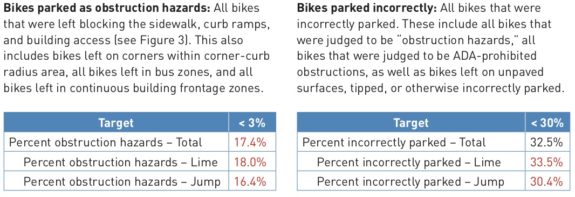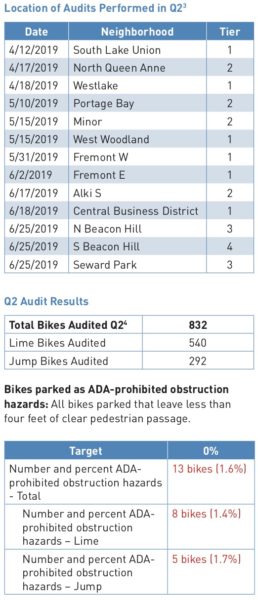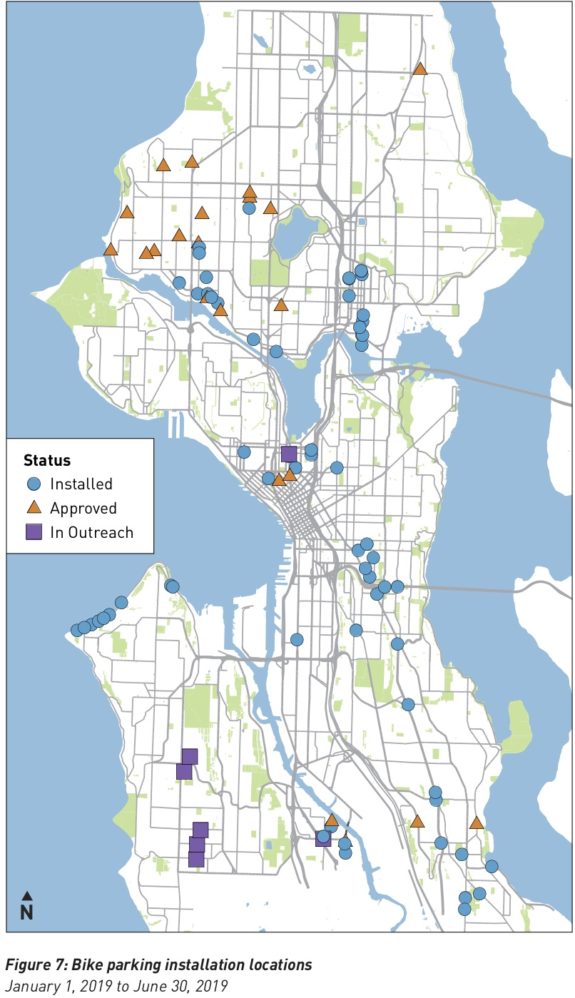The meteoric rise of bike share in Seattle in recent years has plateaued as the number of bikes in operation shrink and prices rise. However, despite these changes, people in Seattle took about as many bike share rides in the second quarter of 2019 as they did in 2018, showing that demand for the service remains strong.
In quarter 2 of 2018, people took 595,000 trips when there were about 10,000 bikes, some of which were $1 pedal bikes and some of which were Lime’s e-bikes that cost an extra 5¢ per minute, according to SDOT’s Quarter 2 Bike Share Summary Report (PDF). In quarter 2 of 2019, people took 588,000 trips on about 5,000 bikes that cost 25¢ per minute.
So the good news is that bike share use is still strong, and a single e-bike seems capable of doing the lifting of multiple pedal bikes. But the bad news is that fewer bikes and higher prices have stemmed the growth in bike share use, which had been climbing fast since the services launched in summer 2017.
This report comes as the city is developing the details for an upcoming e-scooter share permit. Scooters have shown to be more popular than bikes in many other cities, and companies have been trying to convince Seattle to permit them for years. So this time next year, we may have scooter data to add to SDOT’s quarter 2 report.

 The report also notes that bikes continue to block sidewalks and curb ramps too often. Nearly a third of bikes audited were found to be parked incorrectly, though there are plenty of places that technically are not allowed for bike parking but don’t really cause issues (an unpaved planting strip, for example). 17.4% of bikes were found to be “obstruction hazards,” which includes “bikes that were left blocking the sidewalk, curb ramps, … building access, on corners within corner-curb radius area, all bikes left in bus zones, and all bikes left in continuous building frontage zones,” according to the report. About 1.6% of bikes were found to be the worst: ADA-prohibited obstructions, which means the bike did not leave at least four feet of space for people to get through.
The report also notes that bikes continue to block sidewalks and curb ramps too often. Nearly a third of bikes audited were found to be parked incorrectly, though there are plenty of places that technically are not allowed for bike parking but don’t really cause issues (an unpaved planting strip, for example). 17.4% of bikes were found to be “obstruction hazards,” which includes “bikes that were left blocking the sidewalk, curb ramps, … building access, on corners within corner-curb radius area, all bikes left in bus zones, and all bikes left in continuous building frontage zones,” according to the report. About 1.6% of bikes were found to be the worst: ADA-prohibited obstructions, which means the bike did not leave at least four feet of space for people to get through.
As a result of the audit, the city further reduced the fleet sizes for each company, though both Lime and Jump were already operating below their new limits. But “these enforcement actions have a cumulative impact, and unless improvement is seen, further reductions may require vendors to temporarily or permanently remove bicycles,” the report notes.
The city is working to expand the supply of bike parking both for personal bikes and free-floating bikes, adding more than 700 spaces so far in 2019 with the goal of adding another 800 by the end of the year. About 70% of the new spaces have been in new on-street bike parking corrals, which are often located adjacent to crosswalks where car parking is already illegal within 20 feet (probably the most-broken traffic law in the city). These corrals improve the supply of bike parking, help keep sidewalks clear and improve visibility at crosswalks.









Comments
15 responses to “Bike share use steady with fewer bikes and higher prices, but bike parking remains a problem”
Why is the city picking on poorly-parked shared bikes, when we also have private cars and delivery vehicles blocking sidewalks, bike lanes, and bus lanes? Can we get the car companies to come in and reclaim these vehicles from people who clearly are unable to operate and store them safely?
Or fine Uber and Lyft when the “independent contractors” block bike lanes, sometimes (I’m looking at you, Amazon on Sixth Avenue) directly in front of off-duty cops directing traffic.
Just allow the bikes to park on the street like every other vehicle.
Bike share bikes parked all over the place is a problem here in Ballard and I am sure many other neighborhoods, it is a problem. It appears that the people that use these bikes don’t think about parking them out of the path of pedestrians! I live near the Ballard community center and recently a bike corral was installed on 28th across from the BCC! The only bike that I have seen in that corral in the past three week is one that I put there because it was dumped on 28th with what appeared to be some electrical fire damage, the lock was broken and brakes didn’t work (I reported it and it was removed). But no one is using this corral. Users need to be penalized if they leave these bikes in places where they could be a hazard. The two companies, Lime and Jump need to enforce these law and not let these bikes block the right of way for pedestrians.
[…] Seattle Bike Blog updates us on the state of bike-share in Seattle. […]
though I have not used bike share and am very unlikely to use it, I will comment. what is the causal connection that SDOT sees between the number of dockless bikes and illegal parking? the behavior of dockless bike users and vandals is the issue. the attractiveness of dockless bike share depends on its ubiquity; numbers help it be everywhere and have a short wait time.
other commenters in the chain ask about enforcement of auto users, especially Uber and Lyft. they should not be allowed to block arterials or make dangerous U turns. enforcement is costly. what leverage does SDOT have over the TNC?
the bad actors are harming pedestrian and transit flow.
do we like the Joel comment: let the dockless bikes park in the street with the parallel parked cars? the SDOT trial was to put them in painted areas.
For the 17.4% that were “obstruction hazards”, it would be useful to know where the rider should have parked the bike in each case. Clearly, some riders just leave the bike any place convenient for them. But I’m pretty sure there are a significant number of cases where the rider is simply exasperated because there is no good place to leave the bike.
But the biggest problem may not be lack of suitable parking places but simply rider education. I took a quick look at Uber and Lime sites and can’t find anything about parking other than some extremely general statements. Further, a quick search “seattle bike share parking rules” did not turn up anything useful. How are people supposed to know in the first place !
I amend slightly: seattle.gov does have a bike parking page. It’s pretty common sense but leaves plenty of room for interpretation – and violation of the actual code. The also provide a diagram but it’s too large to view on a phone and pretty cluttered. Not too useful, in my opinion.
Yeah, people should be more considerate when parking bikes. But on my block, two people regularly park their cars blocking the sidewalk on a busy arterial, forcing people in wheelchairs and with strollers into the street. Who is auditing g that? Or giving parking tickets?
Don call parking enforcement! 206-625-5011. Choose 6 when the menu starts. It’s the SPD nonemergency line so you may have to wait a while, but your call will be answered. Ask for a parking officer. Usually an officer turns up pretty quickly. Your neighbors should get the message pretty quickly. I’m a frequent “customer” because our alley is frequently obstructed by transit riders who leave their cars in my neighborhood. Parking enforcement works.
I find that most all bikes are parked reasonably enough, meaning they don’t block my way or someone who is handicapped. Might not be legal per code but probably ok in a practical sense.
The bigger problem may simply be street clutter. Bikes left every which way and in random places make the street look messy, at least in some people’s eyes. While that would be hard to write an ordinance for, it does cause strong motivation for people to complain. I’ve heard a number of people mention how they don’t like bikes left everywhere, regardless of whether they are in the way.
I don’t like seeing cars parked on the street, but I see them everywhere. How did that become normalized? Bike parking should also be normalized.
Or decreasing the # of cars allowed on our roads by 2000 every few months when they do a car parking audit?
[…] SDOT rolls out their latest bikeshare report. SBB summary is here. […]
[…] February saw a significant decrease). Meanwhile, bike share use is largely the same as in 2018, according to a recent city report. So it seems that in 2019, more people are riding their own bikes more often. Could the clear rise […]